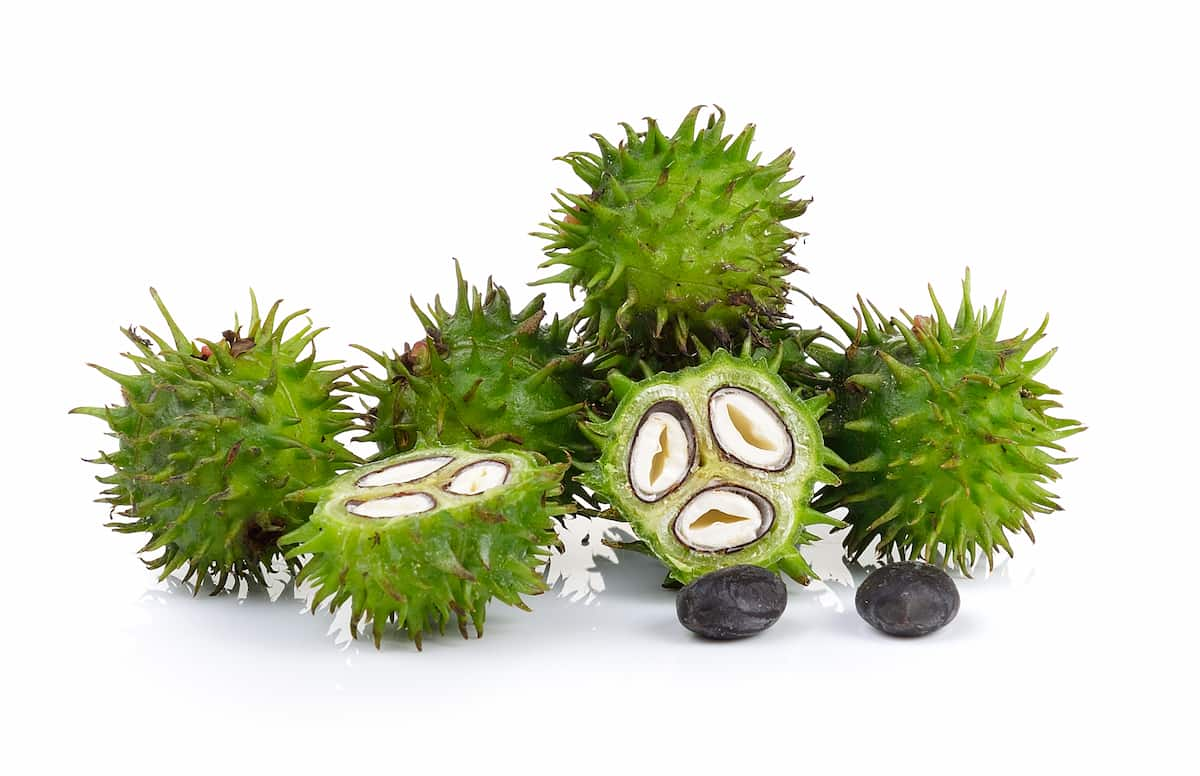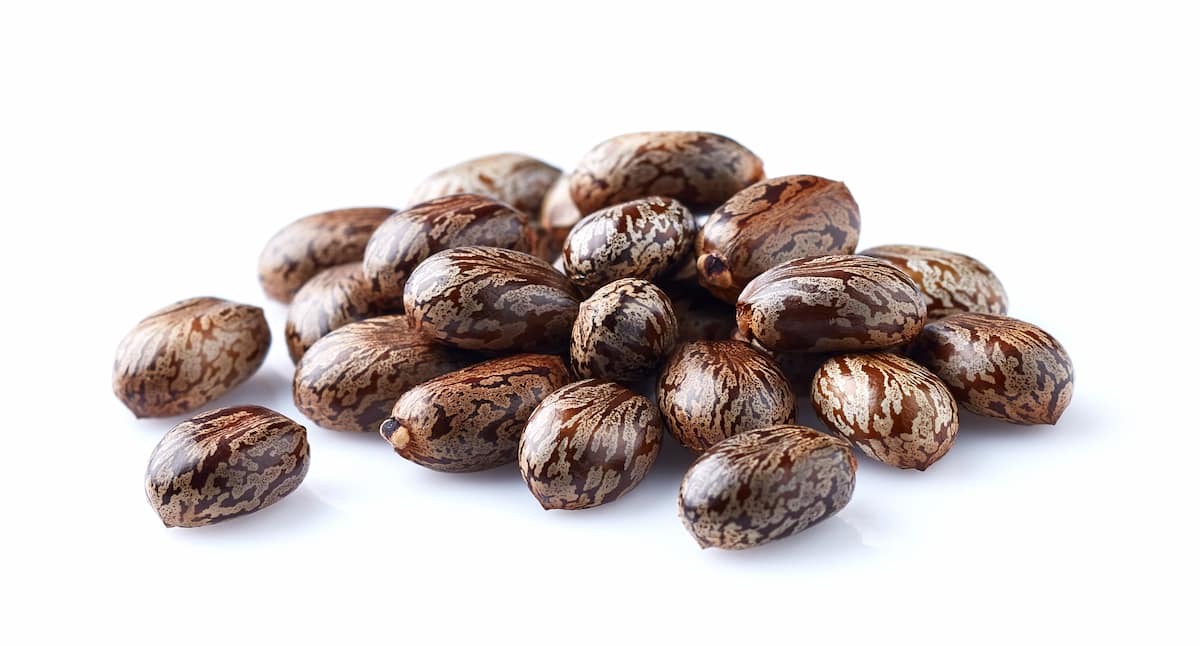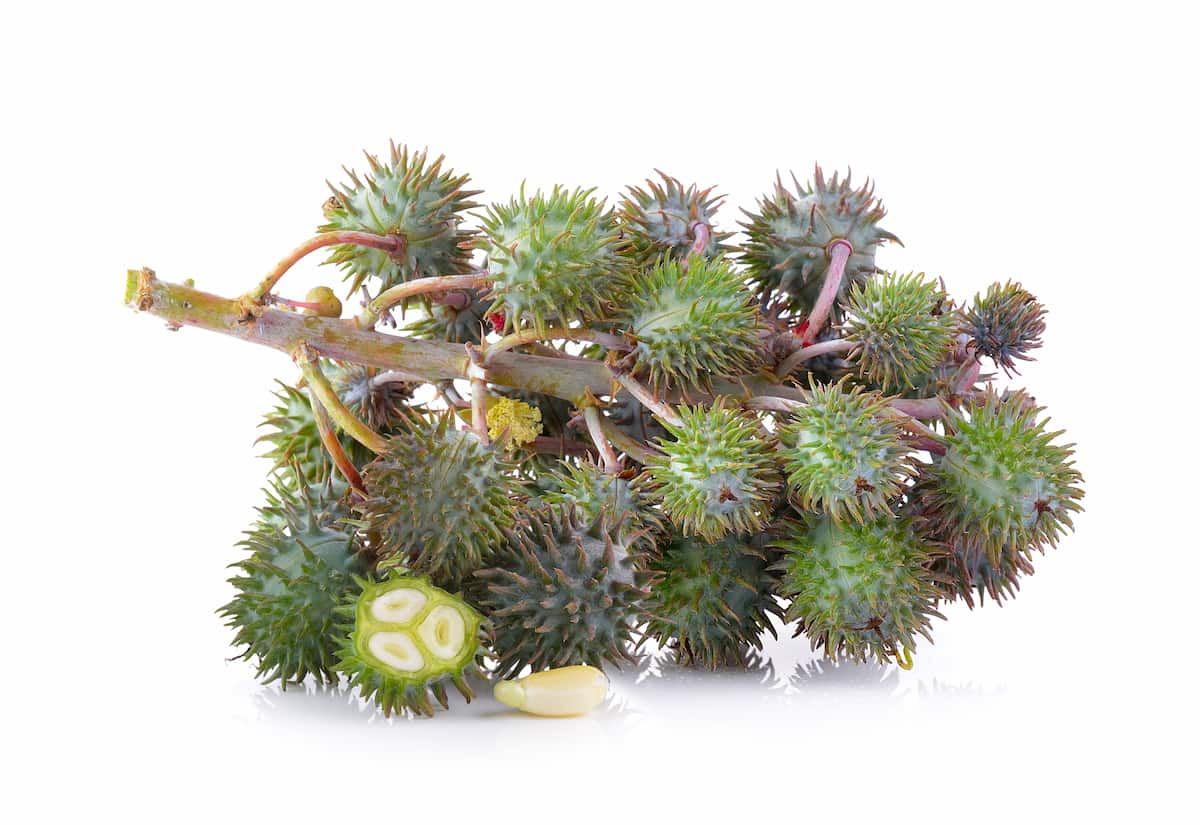Castor (Ricinus communis) is an oilseed crop that produces oil traditionally used as medicine, lubricants, hairdressing, and a laxative. Oil and derivatives have now found industrial use in over 250 products, including hydraulic oil, jet engines, soap, varnish, paint, and nylon threads industries. Popular derivatives include hydroxystearic acid and dehydrogenated castor oil. Castor takes 30-75 days for flowering and 5-10 months for seed yield.

The castor stem is erect, partially hollow, with good branching and marked nodes. It can be red, green, or a mix of both and increases in length with height. The inflorescence is borne terminally on branches and consists of large, apetalous flowers in terminal sub-panicled racemes, with female flowers occupying the upper portion and male flowers in the lower portion.
Castor Production Guide
Best Package and Practices of High-Production Castor
To achieve high-production Castor, best practices include selecting high-yielding varieties, proper land preparation, timely sowing, spacing, and fertilizer application. Effective weed and pest management, irrigation, and regular monitoring are essential. Proper harvesting and post-harvesting practices, including drying, threshing, and storage, are also crucial to maintain seed quality.
Land/ Field Preparation and Soil Requirements for Castor
Castor can grow on various soil types except for wet clays. It prefers red loam soils in peninsular India and light alluvial soils in northern states. It can be grown on inferior soils unsuitable for other crops. The crop is intolerant to soil alkalinity but can handle slightly moderate acidity. Deep plowing in summer is necessary to break compact soil layers, allowing roots to penetrate for better moisture absorption. Ideal soil pH should be around 6.0, and disc harrowing followed by plowing is necessary to level the seedbed and destroy weeds.
Temperature, Climatic, and Rainfall Requirements for Castor
Castor requires moderate temperatures of 20-27°C and low humidity throughout the growing season, thriving in warm, sunny areas. Prolonged cloudy weather during flowering can result in poor seed setting, known as gender reversion, and high temperatures over 41°C can cause flower blasting. While drought-resistant, even distribution of 80-100mm rainfall is optimal, and heavy rainfall during flowering can reduce yields.
Propagation Method and Seed Quality for Castor
The propagation of Castor is done exclusively through seeds
Seed Treatment for Castor
To prevent seed-borne diseases like root rot and Alternaria blight, it is recommended to treat castor seeds with 2g/kg Carbendazim and soak them in water for 18-20 hours. Seed priming with 1% Kcl for 3 hours and sowing seven days before the monsoon onset is advised for rainfed situations.
Seed Rate and Spacing for Castor
For Castor cultivation, a seed rate of 10-12kg per hectare is sufficient and can vary depending on the cultivar and sowing method. It is typically planted before the rainy season in June but can be grown year-round with irrigation. Spacing should be 90-120cm row to row and 40-60cm plant to plant.
In case you missed it: Pea Production Guide: A Step-By-Step Cultivation Practices

Sowing Method for Castor
Seeds can be sown using a plow furrow, a seed drill, or hand dibbling.
Crop Rotation and Intercropping in Castor
Farmers can increase their income through intercropping. Castor crops can be combined with groundnut or black gram, with every row of Castor planted with six rows of peanuts or black gram. For rainfed conditions, intercropping Castor with green or black gram in a 1:2 ratio is recommended. Castor can be intercropped with onion in a 1:2 ratio for irrigated conditions with a spacing of 1.5 x 1.0 m. Crop rotation can involve Castor with wheat, mustard, onion, pearl millet, groundnut, guar, sorghum, or vegetables. Intercropping options for dry farming include Castor with sunflower (1:2), soybean (1:1), or cluster bean (2:1).
Manure & Fertilizer Applications in Castor
- Spread 12 to 13 tons/ha of well-decomposed farmyard manure (FYM) or compost evenly on the field before the last plowing and incorporate it into the soil using a country plow.
- Apply 25 kg sulfur/ha through gypsum during the last plowing to improve castor yield.
- For Castor, apply a fertilizer dose of 40:40:20 kg/ha of N:P: K. Apply a full dose of P, K, and half of N as basal application. The remaining half of N should be applied one month after sowing when soil moisture is adequate.
Weed Management and Herbicide Application in Castor
Effective weed management is crucial for crop yield as weeds compete for nutrients, fertilizers, manures, and water. One or two rounds of weeding and hoeing with bullock-drawn implements are recommended to control weeds in castor crops. The plants may also need to be earthed up. For chemical weed control, pre-emergence herbicides such as Pendimethalin @ 3 liters/ha or Fluchloralin @ 2 liters/ha can be applied three days after sowing, followed by two rounds of hand weeding on the 21st and 40th days after sowing the seed.
Water Management in Castor
Although Castor is primarily grown under rainfed conditions, it responds well to irrigation. As a deep-rooted crop, Castor can extract water from considerable soil depths, allowing for relatively heavy and less frequent irrigations. For higher yields, 2-3 heavy irrigations can be given, with one essential irrigation provided during the flowering stage if soil moisture is deficient. In heavy rainfall areas, proper drainage is crucial. Under irrigated conditions, 3-4 irrigations should be given 15-20 days after the monsoon season ends.
Disease Control in Castor
Several diseases affect castor plants, such as seedling blight, Alternaria blight, Cercospora leaf spot, powdery mildew, and wilt. Seedling blight causes dead seedlings and can spread from the cotyledonary leaves to the stem. Alternaria blight creates irregular, scattered spots with concentric rings on the aerial parts of the plant and can result in premature defoliation and small, underdeveloped capsules.
Cercospora leaf spot appears as minute black or brown spots surrounded by a pale green ring and can cause large brown patches of dried leaf. Powdery mildew creates a powdery mass covering the entire leaf, and wilt causes leaves to droop and drops off, leading to plant death. These diseases can survive in soil debris or seeds and are favored by high humidity, warm or cool weather conditions, and low soil moisture.
Pest Control in Castor
Redheaded, hairy caterpillars and castor semi looper are two serious pests of various crops in India. The former has redheaded, dense reddish-brown hairs and scrapes under the leaves in the neonate stage. The latter has a yellowish-green caterpillar that feeds on leaves and can cause complete devastation to the crop. Both pests have natural enemies, such as parasitoids and predators, including ladybird beetles, spiders, and praying mantises.
Harvesting and Threshing of Castor
Improved castor cultivars usually mature in 140-175 days. Once harvested, the crop must be dried in the sun for a few days before threshing it with a stick or using a Castor Sheller. In rural areas, bullocks are often used for threshing. Finally, the seeds should be separated by winnowing.
In case you missed it: Barley Production Guide: A Step-By-Step Cultivation Practices

Castor Yield per Acre
The yield of castor crops varies based on factors like cultivar, soil type, irrigation, climate, and cultural practices. Rainfed crop yields 250 to 500 kg/ha, mixed crop yields 100 to 200 kg/ha, and irrigated crop yields 550 to 800 kg/ha, on average.
Conclusion
Castor cultivation can be profitable and sustainable for farmers with the proper selection of cultivars, good agronomic practices, and pest management techniques. With suitable climate, soil, and water resources, castor yields can be optimized to meet market demand.
- Feed Your Flock for Less: Top 10 Tips to Save on Chicken Feed
- Ultimate Guide to Ossabaw Island Hog: Breeding, Raising, Diet, and Care
- Hatching Answers: The Top 10 Reasons Your Chickens Aren’t Laying Eggs
- Eggs and Economics: Breaking Down the Cost of Raising Backyard Chickens
- Defend Your Greens: Proven Methods to Keep Iguanas Out of Your Garden
- Ultimate Guide to Cinnamon Queen Chicken: A Comprehensive Guide for Beginners
- Ultimate Guide to California Tan Chicken: Breeding, Raising, Diet, Egg-Production and Care
- Ultimate Guide to Marsh Daisy Chicken: Breeding, Raising, Diet, and Care
- 10 Types of Chicken Farming Businesses You Can Start for Profits